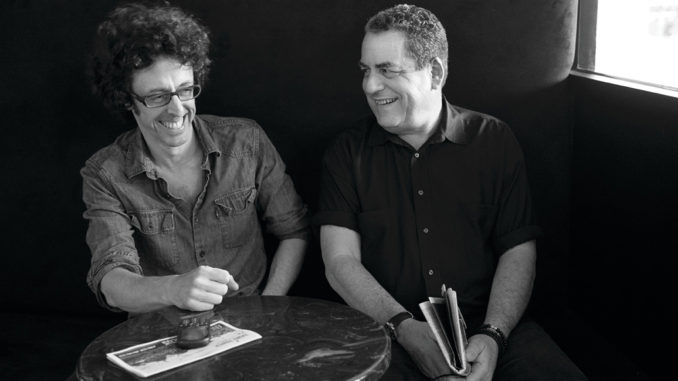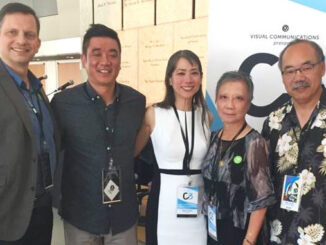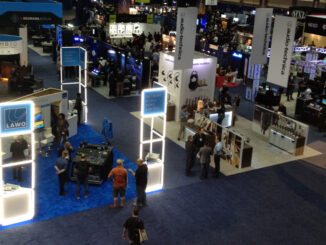
by Rob Feld • portraits by Sarah Shatz
You have to be willing to roll with a few punches to work on an Abel Ferrara movie. It’s a lesson picture editor Anthony Redman learned some 30 years ago when he first found a constant collaborator in the director, and which more recent inductee sound editor, sound designer and re-recording mixer Neil Benezra seems to re-learn every day. Ferrara, the prolific New York iconoclastic indie staple, maker of such controversial films like The Driller Killer (1979), King of New York (1990), Bad Lieutenant (1992), Body Snatchers (1993) and, most recently, Welcome to New York (due this fall from IFC Films), focuses on the darkest underbellies of human experience, with a shooting style to match.
“It’s run-and-gun,” says Redman, who knew from childhood after seeing Citizen Kane in an Orson Welles triple bill that he would work in film, and discovered editing at UCLA film school. He worked in the film library at Universal Studios doing outside sales, but would ask for sequences to cut while servicing editors with film for Universal’s TV shows. “That was one thing that got my chops up,” he recalls. This led to an eight-year apprenticeship and a job on the series Kolchak: The Night Stalker (1974-75). But once he found indie film via Roger Corman, Redman was hooked.
Benezra began by studying architecture at the Pratt Institute in New York but then switched to music theory and composition at Hunter College. His varied experiences have seen him designing sound for the museum exhibitions of many prominent video artists, writing music for off-Broadway shows and working with New York avant-garde theatre creator Richard Foreman. “I worked in his New York theatre for years doing sound, and then toured with him through Europe and Asia for seven years,” Benezra remembers. “We would go to different festivals and re-create the sound design of a play, which was layered and complex. We’d go from a small, black box theatre one night to an opera house the next. It gave me a good taste for how to translate my mixes from working in small rooms to a lot of different situations.”
“I’m always cutting while we’re shooting… I won’t make changes at that juncture; I have to keep going forward.” – Anthony Redman
Ferrara’s desire to capture a sense of reality has called upon all of both editors’ acquired skills, as he shoots in found or live locations, sometimes grabbing shots without even acquiring city permits. Welcome to New York, which imagines the sexual-assault scandal that brought down French presidential hopeful Dominique Strauss-Kahn (played by Gérard Depardieu), combines the varied visual and sonic textures of hotel-room sex parties, gritty prison environs and an affluent New York townhouse.
No matter where they are, though, Ferrara speaks to his actors through every take, all of which provides additional challenges for Redman and Benezra as they meld sights and sounds into the director’s particular vision of New York’s unique reality. CineMontage interviewed the pair in late May about the new film and working with Ferrara.
CineMontage: Anthony, describe the contrast between the studio television world and Roger Corman’s, and why you decided to make a home in independent film.
Anthony Redman: I belong in independent films. I knew that early on. Working within the studio system was not something suited to my personality; I’m a little too much of a prima donna, I have too much attitude.
The Corman movie was Thunder and Lightning [1977] with David Carradine. It was a hillbilly comedy with car chases. I got a lesson from Roger that I’ll never forget. He saw the first cut I did with the director, whose motto with the car chases was “less is more.” So these were very subtle car chases. When Roger saw this he said, “Umm, Tony? This isn’t very exciting.” I said, “I understand perfectly, Roger. If I have a wheel in dailies, it’s going to be on the screen.”
We recut the whole show and I did what I thought Roger wanted. When he saw my cut he said, “Umm, Tony? I think you overdid it.” I took it to heart. There’s no overdoing it with me. It’s easier to take film out than put film in. But with Abel, I rarely have to take anything out. The other lesson Roger taught me was when we had a moonshine still blow up. If there’s an explosion shot with three cameras, “Tony, we have three explosions.”

CM: I imagine you have a way of working by now, but when you first met with Ferrara, what did he say he wanted from you?
AR:I came on to do a recut of Fear City [1984]. Abel gave me no feedback at all. He said, “You’re an editor, go edit,” and then we talked about it after. For me, that’s fabulous.
Neil Benezra: I had worked on a film that Abel executive produced called Happy Life [2011]. I got a call from the director, Michael Bilandic, saying Abel was looking for someone to do sound for 4:44 Last Day on Earth [2011], and could I be in Little Italy in half an hour? Abel was holding court there. We talked about sound, music and films a little bit. When he found out I was from the Bronx and Queens, he pretty quickly said, “Well, you can do this.” But then it was really sink or swim.
AR: We tortured him.
CM: Is there a hazing process?
AR: Yeah, there is. Inevitably, there’s one scene Abel hates and keeps going back to.
NB: In this one, it’s when the girls are out on the rooftop. Abel was very specific about capturing that early morning city. He said, “No one has ever done it!”
AR: What does New York sound like at five in the morning? Two girls in silhouette against the rising sun. He really wanted early morning New York. Very muted.
NB: He definitely had something in his head. In those circumstances with Abel, at first I’m not sure if I capture it, but at some point he stops focusing on it, so I assume I have it.
“In the prison scenes, I added in a lot of sound, which I got by going around with the guards… I try to find something hidden in those vérité moments, where there’s always some kind of sound in the room… It might be a hum or tone, like that buzz going on in the jail scene.” – Neil Benezra
CM: What is the process you two have working with Ferrara?
AR:I’m always cutting while we’re shooting, but it’s not like Abel comes and looks at it. I have had directors do that, but I find it annoying. I won’t make changes at that juncture; I have to keep going forward. Abel uses my cut as the good blueprint, and we take it from there. I want to have a good first cut a few weeks after they wrap. I learned this the hard way. When I first started cutting, I would anguish over every cut and it would take me forever. Abel doesn’t shoot a lot but he re-sets within a take. He also talks all the way through the takes, so he’s a huge sound issue. It’s a nightmare. I know how to get rid of that stuff because I fill my own tracks.
This is because my first real job was as a dialogue editor for Robert Altman. I learned a lot. We had all this film that had to be synced to eight-track. The coding would be off by 100, and you’d be trying to out by how much it was off so you could adjust the film. It was on California Split [1974] with George Segal and Elliott Gould. We had used car lots, bars and racetracks; it was an education. So I do have a really good ear, but because Abel talks over everything, I can only go so far before Neil takes it. In the sex scene with the two brunettes in Welcome to New York, if you listen carefully, Abel is still in there a little bit. It drove me nuts.
NB: You have to strategically cover it with something else — like a chair bump. The advantage I had was that I was given access to the set, so I could get some wild lines and any extra sound that caught my ear. Every day I would watch the dailies then go back in and try and get what we missed. I also have the top restoration tools so I can get away with a lot.
In one shot in particular, the conversation in the townhouse, Jacqueline Bisset kept hitting and covering her lavalier mic, and the boom had terrible pick-up, so we got down to the final mix and were still struggling with it. Abel actually had a great idea; Gérard Depardieu was right by a chair and he stepped back during a shot, so Abel said, “Why doesn’t he just bump into the chair?” So we had a little extra line coverage with the chair squeak. Whatever it takes, just make it work.
AR: We don’t believe in ADR. It never feels right.
NB: It’s artificial, and a lot of Abel’s style is in the moment, trying to capture it.
AR: So no overdone Foley, either. The subject matter lends itself to this kind of approach. We dubbed Bad Lieutenant[1992] in four days on the crappiest mixing board you ever saw. We have to go for the immediacy of whatever’s on film. That’s always been our signature. The closest we ever came to a studio film per se was Body Snatchers [1993]. That’s a very slick film and the only one we ever made like that.
CM: What sort of cutting services that vision?
AR:I try to do everything as adroitly and elegantly as possible. I could cut it funky, but by cutting it as elegantly as possible, it ups the level of what we are doing because you have this very funky film, but in a way it’s all kind of smooth. I don’t cut unless it’s necessary.

and Anthony Redman.
CM: Each location in Welcome to New York has a different quality to the sound. How do you accomplish that, Neil?
NB: In the prison scenes, I added in a lot of sound, which I got by going around with the guards. I actually had access to prisoners. So a lot of it is fabricated but based on reality. I try to find something hidden in those vérité moments, where there’s always some kind of sound in the room that most people would consider a negative sound. It might be a hum or tone, like that buzz going on in the jail scene. I lay in other tones, sounds and groans to bring it out more, giving it a bit of a surreal quality. I also take a lot of things away. Even when in the documentary style — in particular when they were interviewing the maid he assaulted — I like to build up sound and then pull it all away almost like a zoom. I saw that as a great opportunity. I didn’t even get the full effect of it until I went to a screening a few weeks ago and it pulled me in an unexpected way. There was more attention and focus on her emotion.
I look for those opportunities when there is already something there to enhance. In Abel’s films, it seems there’s always a good back and forth between these moments that are to me variously cinematic — like driving across the bridge, when I can think of the sound more cinematically — and then those vérité moments. The more reality-based moments bring the cinematic moments further forward. This contrast is what I’m interested in.
CM: There’s not much of a score in this film.
NB: During the first film we did together, Abel said, “Everything is music. The city is music. We can make those horns sound like trumpets. That’s what you should be looking for, those moments.” And that’s what we always try and find and then add to. Sometimes it’s there already. Sometimes it’s, “That car horn, slow it down. Throw some reverb on there, let’s stretch it and make it into something else.” I had made a lot of abstract, layered sound, collage-type music, and I understood that anything could be turned into music from working with Richard Foreman’s experimental company, the Ontological-Hysteric Theater, like substituting someone’s scream for the sound of a door closing. I also worked on a few experimental films with James Franco and his Rabbit Bandini Productions. I tend to think of everything in an abstract way. Two of my main film sound influences are Eraserhead [1977] and Stalker [1979].
CM: Gérard Depardieu is horribly out of shape, and his character is something of a monster, which led to these huge grunts and snarls during the sex scenes.
NB: So much of it was there already; it was more about recognizing it and then pushing it in the mix. I first recognized it on set, played it for Abel in my car, and he said, “This is f*cking great. This is it.” There’s definitely an animalistic aspect to it, and I think some of it was put on. It helped having a lavalier mic on him, and I had Gérard record about five minutes of grunting and breathing.
Abel’s films capture the moment they’re in. It’s a learning experience for me. He pushed me to a style of sound design that has now become part of my language, whereas in the past I was probably more of a minimalist.
AR: We’re definitely not minimalists.






